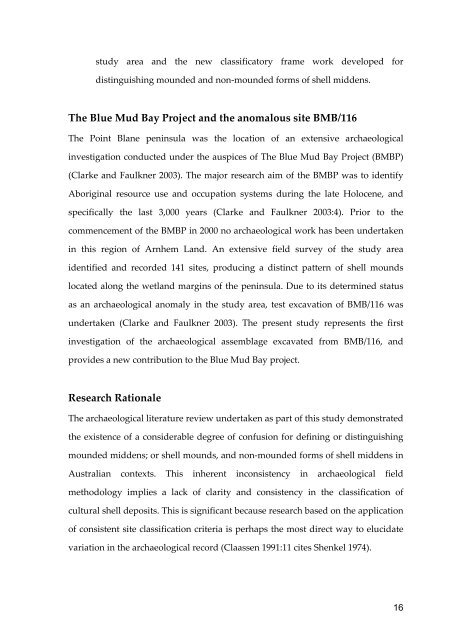One archaeologist's midden is another's shell mound - vanessa ...
One archaeologist's midden is another's shell mound - vanessa ...
One archaeologist's midden is another's shell mound - vanessa ...
Create successful ePaper yourself
Turn your PDF publications into a flip-book with our unique Google optimized e-Paper software.
study area and the new classificatory frame work developed for<br />
d<strong>is</strong>tingu<strong>is</strong>hing <strong>mound</strong>ed and non‐<strong>mound</strong>ed forms of <strong>shell</strong> <strong>midden</strong>s.<br />
The Blue Mud Bay Project and the anomalous site BMB/116<br />
The Point Blane peninsula was the location of an extensive archaeological<br />
investigation conducted under the auspices of The Blue Mud Bay Project (BMBP)<br />
(Clarke and Faulkner 2003). The major research aim of the BMBP was to identify<br />
Aboriginal resource use and occupation systems during the late Holocene, and<br />
specifically the last 3,000 years (Clarke and Faulkner 2003:4). Prior to the<br />
commencement of the BMBP in 2000 no archaeological work has been undertaken<br />
in th<strong>is</strong> region of Arnhem Land. An extensive field survey of the study area<br />
identified and recorded 141 sites, producing a d<strong>is</strong>tinct pattern of <strong>shell</strong> <strong>mound</strong>s<br />
located along the wetland margins of the peninsula. Due to its determined status<br />
as an archaeological anomaly in the study area, test excavation of BMB/116 was<br />
undertaken (Clarke and Faulkner 2003). The present study represents the first<br />
investigation of the archaeological assemblage excavated from BMB/116, and<br />
provides a new contribution to the Blue Mud Bay project.<br />
Research Rationale<br />
The archaeological literature review undertaken as part of th<strong>is</strong> study demonstrated<br />
the ex<strong>is</strong>tence of a considerable degree of confusion for defining or d<strong>is</strong>tingu<strong>is</strong>hing<br />
<strong>mound</strong>ed <strong>midden</strong>s; or <strong>shell</strong> <strong>mound</strong>s, and non‐<strong>mound</strong>ed forms of <strong>shell</strong> <strong>midden</strong>s in<br />
Australian contexts. Th<strong>is</strong> inherent incons<strong>is</strong>tency in archaeological field<br />
methodology implies a lack of clarity and cons<strong>is</strong>tency in the classification of<br />
cultural <strong>shell</strong> deposits. Th<strong>is</strong> <strong>is</strong> significant because research based on the application<br />
of cons<strong>is</strong>tent site classification criteria <strong>is</strong> perhaps the most direct way to elucidate<br />
variation in the archaeological record (Claassen 1991:11 cites Shenkel 1974).<br />
16


